Graphing Quadratic Equations
Here is an example:

Graphing
You can graph a Quadratic Equation using our Function Grapher, but to really understand what is going on, you can make the graph yourself. Read On!
The Simplest Quadratic
The simplest Quadratic Equation is:
f(x) = x2
And its graph is simple too:
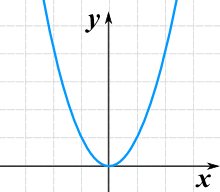
Now let us see what happens when we introduce the "a" value:
f(x) = ax2
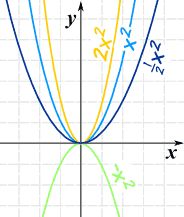
- Larger values of a squash the curve
- Smaller values of a expand it
- And negative values of a flip it upside down
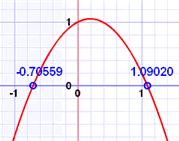 | Play With It
Now is a good time to play with the "Quadratic Equation Explorer" so you can see what different values of a, b and c produce
|
The "General" Quadratic
Before graphing we rearrange the equation, from this:
f(x) = ax2 + bx + c
To this:
f(x) = a(x-h)2 + k
Where:
- h = -b/2a
- k = f( h )
In other words, calculate h (=-b/2a), then find k by calculating the whole equation for x=h
First of all ... Why?
|
So ...
- h shows you how far left (or right) the curve has been shifted from x=0
- k shows you how far up (or down) the curve has been shifted from y=0
Lets see an example of how to do this:
Example: Plot f(x) = 2x2 - 12x + 16
First, let's note down:
- a = 2,
- b = -12, and
- c = 16
Now, what do we know?
- a is positive, so it is an "upwards" graph ("U" shaped)
- a is 2, so it is a little "squashed" compared to the x2 graph
Next, let's calculate h:
h = -b/2a = -(-12)/(2x2) = 3
And next we can calculate k (using h=3):
k = f(3) = 2(3)2 - 12·3 + 16 = 18-36+16 = -2
So now we can plot the graph (with real understanding!):

We also know: the vertex is (3,-2), and the axis is x=3
From A Graph to The Equation
What if you have a graph, and want to find an equation?
Example: you have just plotted some interesting data, and it looks Quadratic:
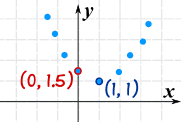
Just knowing those two points we can come up with an equation.
Firstly, we know h and k (at the vertex):
(h, k) = (1,1)
So let's put that into this form of the equation:
f(x) = a(x-h)2 + k
f(x) = a(x-1)2 + 1
Then we calculate "a":
| We know (0, 1.5) so: | f(0) = 1.5 | |
| And we know the function (except for a): | f(0) = a(0-1)2 + 1 = 1.5 | |
| Simplify: | f(0) = a + 1 = 1.5 | |
| a = 0.5 |
And so here is the resulting Quadratic Equation:
f(x) = 0.5(x-1)2 + 1
Note: This may not be the correct equation for the data, but it’s a good model and the best we can come up with.
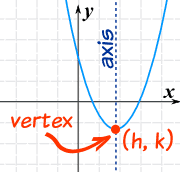
No comments:
Post a Comment